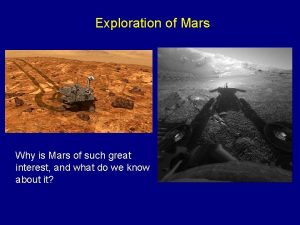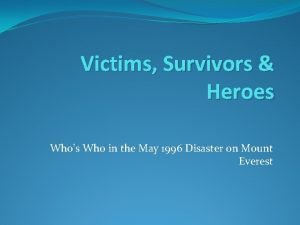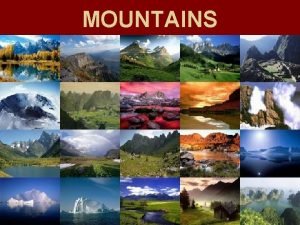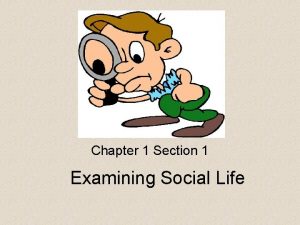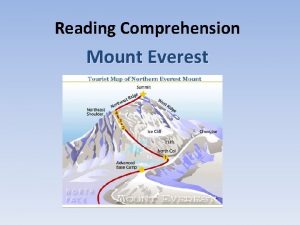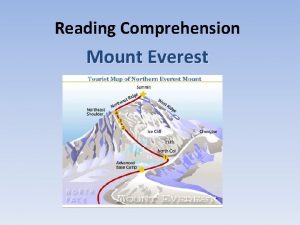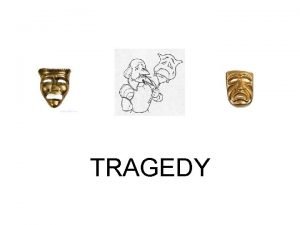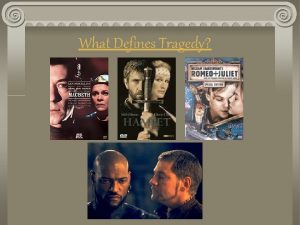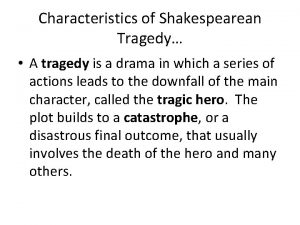Lessons from Everest Examining the 1996 Tragedy 1




















![Status Differences Krakauer: There was a clear “guide-client protocol… On this expedition, he [Harris] Status Differences Krakauer: There was a clear “guide-client protocol… On this expedition, he [Harris]](https://slidetodoc.com/presentation_image_h/ac83d49ae374fac8c2e2afb2cb700d8c/image-21.jpg)








- Slides: 29

Lessons from Everest: Examining the 1996 Tragedy 1 Source: National Geographic

Why Study Everest? Business leaders can learn a great deal from catastrophic failures, tragedies, and decision fiascoes in other fields These case studies offer invaluable lessons in leadership, decisionmaking, and crisis management. 2

Background: The 1996 Expeditions Adventure Consultants ◦ Leader: Rob Hall, 4 successful ascents, 39 clients guided to summit ◦ Guides: Mike Groom and Andy Harris ◦ Clients: Eight including Jon Krakauer & Dr. Beck Weathers Mountain Madness ◦ Leader: Scott Fischer, 1 successful ascent, K 2 ascent, others ◦ Guides: Anatoli Boukreev and Neil Beidleman ◦ Clients: Eight including Sandy Pittman & Klev Schoenig 3

The Path to the Summit Source: Boukreev & De. Walt, 1998 4

How Challenging? Total = 846 Total = 148 5

How Challenging? Source: National Geographic 6

How Challenging? Source: National Geographic 7

How do people make decisions? Rational Completely irrational – Freud Bounded rationality or subjective rationality – Simon 8

The decision making process Problem recognition Information search Construction of alternatives Choice Implementation 9

So where did decision making fail in this case? 10

Beware the “Root Cause Trap” In many cases, scholars and managers seek to find a single “root cause” of a catastrophic failure. In fact, we seem to enjoy pitting competing theories against one another. Often, however, this search for a single root cause is futile; typically, many factors work together to create catastrophic failures. 11

Everest at Three Levels Organization Level System Complexity Mt. Everest Tragedy Individual Level Group Level Cognitive Limitations Team Dynamics 12

Cognitive Bias Systematic biases impair the judgment and choices that individuals make. They affect experts as well as novices, and they affect individuals in a wide variety of professions. n Evidence of five biases in this case: n Sunk cost effect n Confirmation bias n Recency effect n Overconfidence bias 13

Sunk Cost Effect Tendency for people to escalate commitment to a course of action in which they have made substantial prior investments of time, money, or other resources. n To avoid this, Hall & Fischer chose to adhere to a turnaround time. Fischer called it the “Two O’Clock Rule. ” n “If you aren’t on top by two, it’s time to turnaround. Darkness is not your friend. ” § During the climb, however, “turnaround times were egregiously ignored. ” (Krakauer, 1996) 14

Sunk Cost Effect Hansen: “I’ve put too much of myself into this mountain to quit now, without giving it everything I’ve got. ” n n n Krakauer: “You must be exceedingly driven, but if you’re too driven you’re likely to die…[the clients] had each spent as much as $70, 000 and endured weeks of agony to be granted this one shot at the summit. ” Cotter: “It’s very difficult to turn someone around high on the mountain. If a client sees that the summit is close and they’re dead set on getting there, they’re going to laugh in your face and keep going. ” Breashears: “So many times on mountains, we get past this point where we don’t know how to turn around… This ship, this locomotive, is steaming up the mountain, and the only reason to keep going is that the ship is already underway. ” 15

Confirmation bias: The tendency to seek information that will confirm what we already believe, and to avoid data that will contradict our pre-existing views. Put another way, we see what we expect to see. The weather on Everest: ◦ Charlotte Fox: “It was a beautiful day, not a cloud in the sky. ” ◦ Nima Gombu: “We were slow. The weather was also deteriorating…” ◦ Michael Groom: “I was very concerned about the strength of the wind having built up in the 45 minutes that I had been waiting on the South Summit. ” 16

Recency Effect Tendency to place too much emphasis on information and evidence that is readily available, such as recent events. n n Breashears: “Several seasons of good weather have led people to think of Everest as benevolent, but in the mid-eighties – before many of the guides had been on Everest – there were three consecutive seasons when no one climbed the mountain because of the ferocious wind. ” Breashears: “Season after season, Rob had brilliant weather on summit day. He’d never been caught in a storm high on the mountain. ” 17

Overconfidence Bias Fischer: “We’ve got the Big E completely figured out, we’ve got it totally wired. These days, I’m telling you, we’ve built a yellow brick road to the summit. ” n n n Hall: “It’s worked 39 times so far, pal, and a few of the blokes who summitted with me were nearly as pathetic as you. ” Krakauer: Hall believed a major disaster would happen on the mountain that year. However, “Rob’s feeling was that it wouldn’t be him; he was just worried about ‘having to save another team’s ass. ’” Krakauer: Incredibly positive self-assessments on the part of many of the clients. He described them as “clinically delusional. ” 18

Team Effectiveness Psychological safety: “shared belief that the team is safe for interpersonal risk-taking”* Team members demonstrate a high level of trust and mutual respect for one another Team members do not believe that the group will rebuke, marginalize, or penalize individuals for speaking up or challenging prevailing opinions * Source: Edmondson, ASQ, 1999. 19

Leader Behavior Hall: “I will tolerate no dissension up there. My word will be absolute law, beyond appeal. If you don’t like a particular decision I make, I’d be happy to discuss it with you afterward, not while we’re up on the hill. ” § Krakauer: “Passivity on the part of clients had thus been encouraged throughout the expedition. ” 20
![Status Differences Krakauer There was a clear guideclient protocol On this expedition he Harris Status Differences Krakauer: There was a clear “guide-client protocol… On this expedition, he [Harris]](https://slidetodoc.com/presentation_image_h/ac83d49ae374fac8c2e2afb2cb700d8c/image-21.jpg)
Status Differences Krakauer: There was a clear “guide-client protocol… On this expedition, he [Harris] had been cast in the role of invincible guide, there to look after me and the other clients; we had been specifically indoctrinated not to question our guides’ judgment. ” § Beidleman: “I was definitely considered the third guide… so I tried not to be too pushy. As a consequence, I didn’t always speak up when maybe I should have, and now I kick myself for it. ” 21

Lack of Familiarity Boukreev: He was very uncomfortable because he didn’t know many of the other climbers, and he did not find it easy to develop relationships with others during the climb. “I tried not to be too argumentative, choosing instead to downplay my intuitions. ” n Krakauer: “A group of complete strangers…trust in one’s partners is a luxury denied those who sign on as clients on a guided ascent… [we were] a a team in name only. ” 22

Complex Systems Two characteristics of a complex system n Complex interactions: different elements of a system interact in ways that are unexpected and difficult to perceive or comprehend § Tight coupling: time dependent processes, fairly rigid sequence of activities, one dominant path to achieving the goal, and very little slack n n Breashears: “I think of an expedition as a very complex organism… Rob Hall had designed a complicated system that was very rigid. ” Krakauer: “Four of my teammates died not so much because Rob Hall’s systems were faulty – indeed nobody’s were better – but because on Everest, it is the nature of systems to break down with a vengeance. ” 23

The Myth of a Specific Cause “To cite a specific cause would be to promote an omniscience that only gods, drunks, politicians, and dramatic writers can claim. ” - Boukreev & De. Walt, 1998 24

Leadership: The Need for Restraint “Some people have tremendous charisma, and they can dominate a room full of people, but that does not equal competence. Sure, leaders need to have a vision. But by restraint, I mean the ability to accept others’ ideas without feeling threatened. Those are the people I found to be my role models – not the person who ordered me to go up the mountain, but the person who talked to the team, asking for a dialogue, not feeling threatened by the dialogue, because they still had the ability to make the final decision. Some people can tolerate no dissent. But, if you assemble a great team, don’t you want to hear their ideas? ” - David Breashears 25

How does this case help us understand business situations? 26

Cultural Issues in Decision. Making Problem to be solved or accepted Future oriented or past focused alternatives Who makes the decisions? Timeline for decision making Risk levels in choice Think or feel decisions 27

Ethical Issues in Decision Making 28

Storm Over Everest The documentary on the tragedy 29
 Features of shakespearean drama
Features of shakespearean drama What is greek tragedy
What is greek tragedy Shakespeare comedy vs tragedy
Shakespeare comedy vs tragedy What is the warmest month on mount everest
What is the warmest month on mount everest David sharp
David sharp Mt everest
Mt everest Mount everest
Mount everest Mt everest vs olympus mons
Mt everest vs olympus mons Everest
Everest Couloir norton everest
Couloir norton everest Mt everest
Mt everest Everest solvent pvt ltd nepal
Everest solvent pvt ltd nepal Najvyšší vrch na svete
Najvyšší vrch na svete Tim madsen aspen
Tim madsen aspen Why do you feel proud of mt everest and gautam buddha
Why do you feel proud of mt everest and gautam buddha Physical features of mount everest
Physical features of mount everest What is the name
What is the name Anticline
Anticline Hiten roofing
Hiten roofing Zona muerta everest
Zona muerta everest Before mt everest was discovered riddle
Before mt everest was discovered riddle Everest collge
Everest collge Everest 800
Everest 800 Mount everest
Mount everest Examining social life
Examining social life Examining social life practice
Examining social life practice Csi handwriting analysis
Csi handwriting analysis Acquire spiritual knowledge
Acquire spiritual knowledge Sociology
Sociology What conclusions can you make from examining the geochart
What conclusions can you make from examining the geochart







